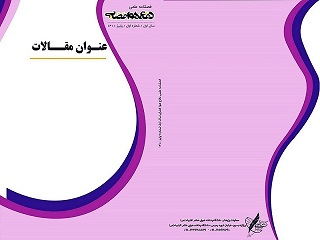نوع مقاله : مقاله پژوهشی
نویسنده
گروه فیزیک، دانشکده علوم، دانشگاه ملایر، ملایر، ایران
چکیده
فریت کبالت با ساختار اسپینلی از مواد مغناطیسی مهم بشمار میرود. این مواد دارای خواص الکتریکی و مغناطیسی جالب با پایداری حرارتی و شیمیایی بالا میباشند. در این پژوهش ترکیب فریتیMgxFe2O4 CO1-X با مقادیر متفاوت از x برابر با مقادیر 0/0 ، 2/0 ، 4/0 ، 6/0 و 8/0 با روش سل-ژل احتراقی تهیه شد. ساختار بلوری نمونههای تهیه شده با استفاده از دستگاه پراش پرتو X (XRD) مورد مطالعه قرارگرفت. ریختشناسی ذرات با استفاده از میکروسکوپ الکترونی روبشی(SEM) مورد بررسی قرار گرفت. ویژگی مغناطیسی نمونهها توسط دستگاه مغناطیسسنج نمونه مرتعش(VSM) مورد بررسی قرار گرفت. همچنین فعالیت فوتوکاتالیستی نانو ساختارهای تهیه شده در تخریب آلودگی آلی با استفاده از طیف سنج فرابنفش- مرئی مورد بررسی قرار گرفت. الگوی پراش پودرهای بدست آمده نشان داد که پودرهای تولید شده دارای ساختار بلوری اسپینلی هستند و هیچ گونه ناخالصی در آن دیده نمیشود. بررسی ویژگیهای مغناطیسی نمونهها نشان داد که با افزایش مقدار منیزیم ماهیت نمونه از فرومغناطیس سخت به نرم تغییر مییابد. نتایج فوتوکاتالیستی نشان داد که این دسته از مواد قادر به تخریب رنگهای آلی در حضور نور مرئی می-باشند.
کلیدواژهها
موضوعات
عنوان مقاله [English]
Study the effect of magnesium on the photocatalytic activity of cobalt ferrite nanopowder destruction of chemical pollution
نویسنده [English]
- Nader Ghobadi
Department of Physics, Faculty of Science, Malayer University, Malayer, Iran
چکیده [English]
Cobalt ferrite with a spinel structure is an important magnetic material. These materials have interesting electrical and magnetic properties with high thermal and chemical stability. In this study, ferritic compound CO1-xMgxFe2O4 was prepared with different values of X 0.0, 0.2, 0.4, 0.6 and 0.8 using a sol-gel combustion method. The crystalline structure of the prepared samples was studied using an X-ray diffraction device (XRD). The particle Morphology was studied using scanning electronic microscope (SEM). The magnetic properties of the samples were investigated by a VSM Magnetized Magnetometer device. Also, the photocatalytic activity of nanostructures prepared for the destruction of organic contamination was studied using ultraviolet-spectrometer spectroscopy. The powder diffusion pattern showed that the produced powders had a spinel crystal structure and no impurities were observed. Investigating the magnetic properties of the samples showed that, by increasing the amount of magnesium, the nature of the sample varies from hard to soft ferromagnetic. Photocatalytic results showed that these materials are capable of destroying organic colors in the presence of visible light.
کلیدواژهها [English]
- cobalt ferrite
- mantative properties
- photocatalyst properties
- sol-gel method

